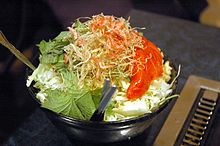Monjayaki: Difference between revisions
The descriptions for the images were incorrect. Showing the before cooking Monjayaki as after and vice versa. Tags: Reverted Visual edit |
swapped before after cooking labels to match the file names |
||
| Line 1: | Line 1: | ||
{{Short description|Japanese pan-fried batter}} |
{{Short description|Japanese pan-fried batter}} |
||
{{Use dmy dates|date=November 2019}} |
{{Use dmy dates|date=November 2019}} |
||
[[File:Monjayaki Before.JPG|thumb|Monjayaki |
[[File:Monjayaki Before.JPG|thumb|Monjayaki before cooking]] |
||
[[File:Monjayaki After.JPG|thumb|Monjayaki |
[[File:Monjayaki After.JPG|thumb|Monjayaki after cooking]] |
||
{{nihongo|'''Monjayaki'''|もんじゃ焼き|4=often called simply "monja"}} is a type of [[Japan]]ese pan-fried [[batter (cooking)|batter]], <nowiki/>popular in the [[Kantō region]], similar to [[okonomiyaki]], but using different liquid ingredients. |
{{nihongo|'''Monjayaki'''|もんじゃ焼き|4=often called simply "monja"}} is a type of [[Japan]]ese pan-fried [[batter (cooking)|batter]], <nowiki/>popular in the [[Kantō region]], similar to [[okonomiyaki]], but using different liquid ingredients. |
||
Revision as of 13:37, 2 June 2023


Monjayaki (もんじゃ焼き, often called simply "monja") is a type of Japanese pan-fried batter, popular in the Kantō region, similar to okonomiyaki, but using different liquid ingredients.
Ingredients
The ingredients in monjayaki are finely chopped and mixed into the batter before frying. Monjayaki batter has ingredients similar to okonomiyaki. However, additional dashi or water is added to the monjayaki batter mixture, making it runnier than okonomiyaki. The consistency of cooked monjayaki is comparable to melted cheese.
Diners eat directly from the grill using a small spatula.[1] Monjayaki diners also participate in the cooking by spreading raw monja on the grill so that crispy bits form and caramelize. Many monjayaki restaurants can be found in the Tsukishima district of Tokyo where the dish is said to have originated. Most of these restaurants also serve regular okonomiyaki.[2]
See also
References
- ^ Goode, Brandi (13 September 2012). "Diner's dilemma: Okonomiyaki or monjayaki?". CNN Travel. Archived from the original on 6 March 2016. Retrieved 13 February 2016.
- ^ Trautlein, Steve (24 August 2012). "The chow-down tour of Kanto's local dishes". The Japan Times. p. 15. Archived from the original on 24 August 2012.
